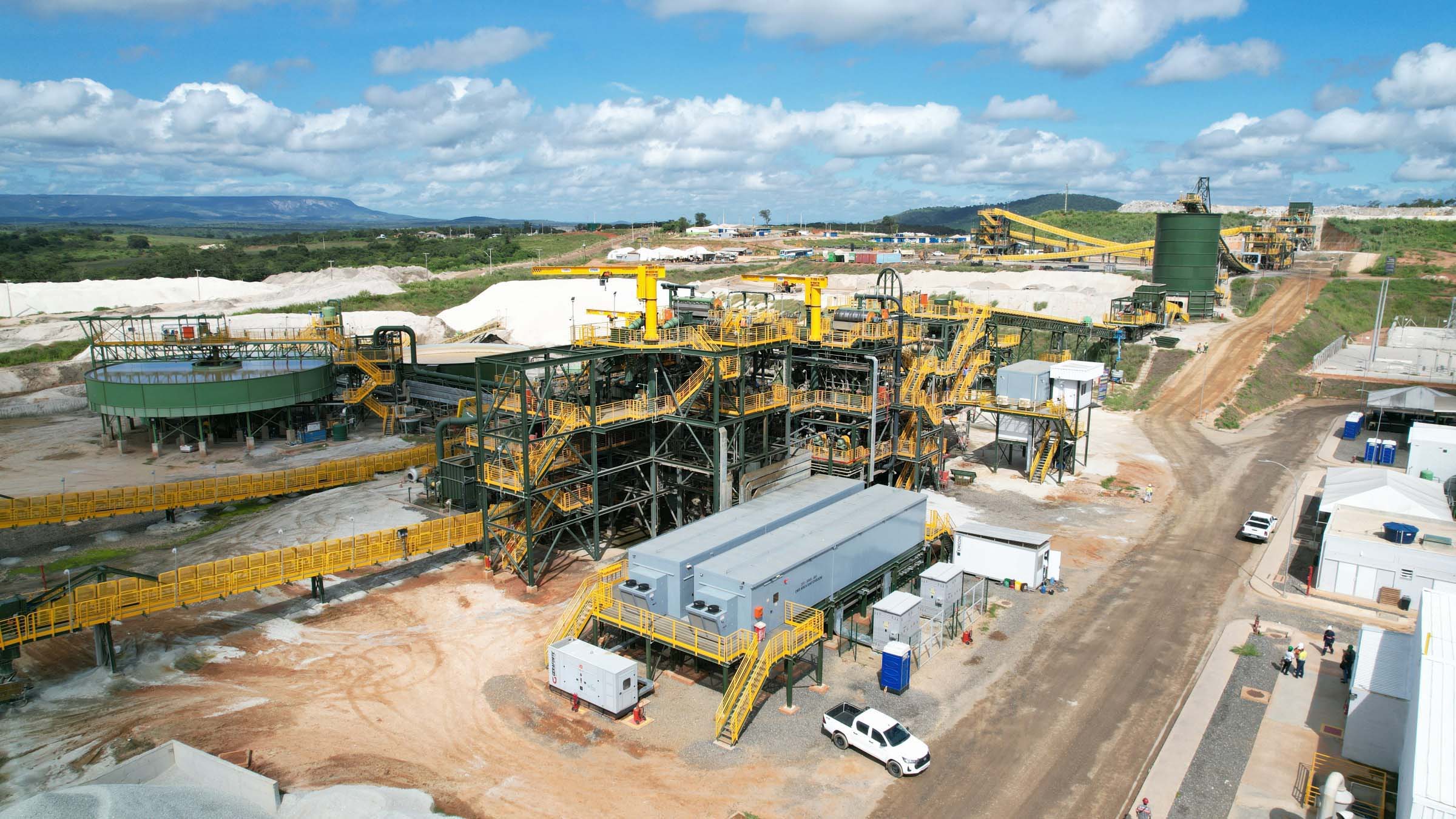Lithium exploration is accelerating in Brazil, in the wake of the relaxing of regulations and growing demand for the mineral that’s crucial to the global energy transition.
The surging shift towards electric vehicles (EVs), for which lithium is an essential component in batteries, is one of the main drivers of a global demand for the mineral that is projected to rise by up to 15 times by 2040, according to the International Energy Agency.
In July 2022, the government of Brazil’s then-president Jair Bolsonaro issued a decree removing restrictions on the country’s lithium’s trade. Until then, exports of the mineral had been restricted due to a 1997 regulation designed to protect the Brazilian nuclear industry, in which lithium was mainly used to power reactors.
Brazil’s opening up to foreign trade in lithium has attracted both domestic and international mining companies. Requests made to the federal government to research and explore for the mineral in the south-eastern state of Minas Gerais – where over 80% of Brazil’s known lithium deposits are located – jumped almost 18 times in just two years, from 45 in 2021 to 851 in 2023, according to a survey conducted by the Minas Gerais-based Federal University of the Jequitinhonha and Mucuri Valleys, seen by Dialogue Earth.
However, analysts tell Dialogue Earth that while lithium exports from Brazil are taking place, these are not adding value within the country, limiting the opportunities to develop domestic industries around the mineral. They also warn that the increase in demand is being accompanied by socio-environmental harms, especially for communities whose traditional ways of life are already being eroded.
Dreams of lithium
Estimates for Brazil’s lithium reserves vary widely. In 2017, the Brazilian Geological Survey, which is linked to the Ministry of Mines and Energy, projected that the country could be home to 8% of global lithium reserves. However, this year, the US Geological Survey determined that Brazil hosts less than 1% of the world’s potential stocks.
These estimates are significantly lower than that of its neighbours in Latin America’s so-called “lithium triangle”, whose members Bolivia, Argentina and Chile collectively sit on more than 50% of global reserves of the mineral. Nonetheless, Brazil’s authorities are harbouring grand ambitions for its reserves.
In May 2023, the governor of Minas Gerais, Romeu Zema, announced his intention to develop a technology centre in the state as part of the Vale do Lítio (“Lithium Valley”) project. This hub would be developed in the Jequitinhonha Valley, in the state’s north-east, which is also facing the prospect of being targeted for massive iron ore exploitation.
The region has previously been dubbed the “valley of hunger” due to socioeconomic deprivation among its mostly rural population. But Zema, who launched the programme in New York in a move to attract foreign investors, said he hopes the region “will become a ‘technology valley’ for the production of batteries and other value-added products”.
The Minas Gerais government told Dialogue Earth that it had formed a working group with executive bodies and private entities to develop the programme. Its aim is to enhance the region, create more than 10,000 jobs and generate income in 14 cities, with an investment that could reach BRL 30 billion (USD 5.4 billion) by 2030.
Several companies are already operating or want to operate in the state. They include Companhia Brasileira de Lítio (CBL), which has been mining in the Araçuaí and Itinga municipalities since 1991, and Canada’s Sigma Lithium, which has been operating in the same municipalities since April 2023. In Nazareno, in the central region of Minas Gerais, Dutch company AMG is extracting lithium from mining tailings and building a plant that is scheduled to open in 2026.
Meanwhile, several foreign companies are awaiting clearance from the federal government to develop projects in the Jequitinhonha Valley, including Canada’s Lithium Ionic, Australia’s Latin Resources, and Atlas Lithium Brasil, a subsidiary of US-based Atlas Lithium. Prospecting requests have also been made in other states.
Questions over planning
Some observers, however, are critical of the means of exploitation, which they say is not boosting Brazilian industry.
“In Jequitinhonha, even with strong support from the state government, there is no initiative to add value [to production],” says Tádzio Peters Coelho, a social sciences professor researching lithium at the Federal University of Viçosa.
Coelho claims that the state government only gives political support to production, exploiting the idea of poverty and backwardness to preach a development perspective for the area. “But it’s just a way of facilitating the approval of projects without major obstacles,” he says.
In Brazil, exploration of the critical mineral is poorly planned, according to Marina Oliveira, who researches lithium and associated inequalities at the Pontifical Catholic University of Minas Gerais.
“There is no solid policy that benefits the entire production chain,” says Oliveira. She suggests that the government consider aspects such as “the contribution of technology, the creation of skilled jobs, the production of electric cars”, in a way that advances industrialisation, but also respects local inhabitants.
This model for developing regional industry would be very different from “just extracting lithium and selling it very cheaply”, as is the case today, Oliveira adds. She claims the Vale do Lítio project only serves to attract investors.
Foreign firms advance in Brazil
The list of parties interested in entering Brazil’s lithium industry includes big names in the global EV industry. In January, the Financial Times reported that China’s BYD, the largest global electric car manufacturer, held talks on a “possible supply agreement, joint venture or acquisition” of Sigma’s Brazil operations, which Sigma declined to comment on. German carmaker Volkswagen has expressed similar interest in a bid to reduce dependence on China for its EV components.
At the latest edition of annual technology event Web Summit, this time held in Rio de Janeiro in April, the president of BYD Brazil, Tyler Li, expressed the company’s desire to ensure an integrated production chain in order to offer lower prices to local consumers. Today, the high cost of EVs is one of the main bottlenecks in this market.
“In Brazil, we have the best benefits. We have almost everything: we have lithium, we have iron, we have aluminium, we have all the raw materials,” Li said at a panel discussion on the growth of the country’s EV industry. “That’s a good incentive for us to build the whole supply chain in Brazil. That could reduce costs a lot.”
As part of this strategy, BYD is building its largest EV factory outside Asia in Camaçari, in the north-eastern state of Bahia, which is scheduled to start operating in early 2025. This is one of several recent investments that could turn Brazil into a hub for the sector in Latin America.
For Elaine dos Santos, a researcher at the Institute of Advanced Studies at the University of São Paulo, the trend could bring benefits to the country: “This would have a direct impact on industry, on job creation and on reducing foreign dependency by improving the supply of parts.”
Dust, noise and cracks
Sigma has touted the production of “green lithium” from its operations in the Jequitinhonha Valley, claiming to exploit a product with “zero carbon, zero coal power, zero tailings dam, zero utilisation of potable water and zero use of hazardous chemicals”. Local residents, however, dispute the truth of this term.
Unlike the lithium extraction from brine pools seen in South America’s “lithium triangle”, Brazil’s deposits are mostly found in hard rock, which requires more conventional digging and blasting. On the banks of the Jequitinhonha River, inhabitants of the village of Cinta Vermelha de Jundiba are feeling the consequences of such processes.
The community, home to the Pankararu and Pataxó ethnic groups, is about 10 kilometres from the Grota do Cirilo mine, where Sigma began extracting lithium just over a year ago. Here, villagers are a short distance from the dust, noise and pollution of the mines.
“When dynamites explode, the air is contaminated; there is an intense emission of dust, and the pollutants travel through the wind. There are also vibrations from the noises,” says local leader Cleonice Pankararu.
With the mining activity, “there is the destruction of the Cerrado and Caatinga biomes; there is a social and economic impact, with a change in the landscape, our culture and our religions”, she adds. “Our rituals depend on a balanced environment.”
Pankararu says she has also noticed changes as more urban development has arrived, particularly in prices in Araçuaí, which have reportedly increased following the arrival of labourers involved in the mining operations. The small room her family used to rent in the city for their children to sleep in during the school week no longer fits their budget. She says she has also observed increases in violence, such as physical attacks, theft and sexual assault since the arrival of workers.
Aline Gomes Ruas, from the Araçuaí chapter of the Movement of People Affected by Dams, an environmental campaigning group, claims that Sigma’s activity has caused instability in the community of Piauí Poço Dantas in Itinga, 8 kilometres south from the mine. Its residents, she says, are trying to learn to live with the many new impacts.
“For more than a year, the community hasn’t known what to do, amid so much noise and dust,” says Gomes Ruas. “The rubble and dust fall into the river, which is no longer the same, as well as on the vegetation and crops. What used to be produced is no longer produced.”
Gomes Ruas says that people in the community now suffer from respiratory problems as a result of dust from the mining operations, and that blasts from the mine have caused cracks to form in the walls of their houses. She claims Sigma does not recognise its responsibility for these problems. The company did not comment on the issue.
In Nazareno, Coelho claims the impacts of AMG’s lithium mining are similar to those of traditional mining, with the mineral’s production entailing the construction of dams, which flood large areas and pose potential risks of collapse, as well as requiring sites for the disposal of polluting materials. AMG also did not comment.
There are also fears that lithium mining will have negative effects on other cities in the state. Luiz Paulo Guimarães, from the Popular Sovereignty of Mining Movement, says he is worried about the municipality of Salinas, where the Australian company Latin Resources Limited is set to invest in two prospecting areas. The area is known for production of cachaça, a popular Brazilian distilled spirit made from sugarcane juice.
“These projects are going to destroy the spring, end the availability of water and make cachaça production unviable,” says Guimarães. “The city known as the cachaça capital is going to lose its identity, its production and its economic potential, in exchange for exploitation that brings far greater harm than good.”
Government prepares lithium plan
The federal government says it is preparing an inter-ministerial plan to exploit Brazilian lithium in a way that minimises local impacts and shares the benefits with communities. At a seminar in April, Jarbas Vieira da Silva, coordinator of public dialogues for the Brazilian presidency’s office, said that the plan “will be a concerted movement between the public authorities and the companies to build a system of governance.” He added that it was developed after a government mission visited affected communities in the Jequitinhonha Valley.
“This is already being stitched together, built and discussed internally,” Vieira da Silva said.
The Ministry of Mines and Energy told Dialogue Earth that it will launch an initiative to expand the supply of strategic minerals such as lithium in relation to the energy transition. The plan will reportedly include developing an industry to process these minerals domestically for entering the value chain of batteries, wind turbines and electric motors.
The ministry added that it will work to attract investment, form partnerships and encourage technological development, especially in mineral processing, as well as train labour and develop the necessary infrastructure.
But while these plans by the federal government and Minas Gerais state are still being established, communities must deal with the local impacts, and exploration continues without a solid strategy, says Oliveira.
“The fear is that we restrict ourselves to the extraction process without advancing development and end up reinforcing inequalities and social impacts, while profits and benefits go to the developers,” she notes.












